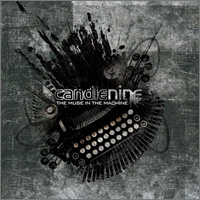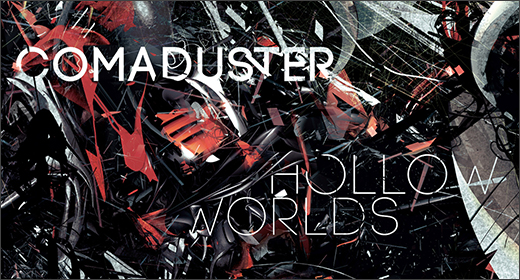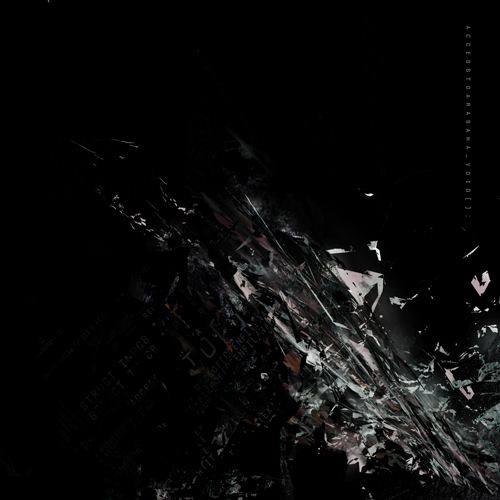
(May 2010) The cover of Candle Nine’s The Muse in the Machine is adorned by a mutated, smashed and shattered, ink-spattered antique typewriter that evoke something of the visceral and bizarre body-horror of a David Kronenberg movie. Certainly film informs the album to a degree – there’s an unusual selection of movie samples peppered throughout – but the cyberpunk aesthetic exemplified by certain video games quickly becomes apparent as the dominant influence, and the fingerprints of one game in particular can be found all over it.
That game is 1999’s System Shock 2 and it infests The Muse in the Machine to such a degree that the percussive and textural characteristics appear to have been inspired by the voice of its central villain, the megalomaniacal rogue artificial intelligence, SHODAN. Its tripled, malfunctioning voice was one of the many creepy and atmospheric devices that boosted the game’s success: it would randomly stutter, glitch, pitch shift, time-stretch, repeat and distort, and these digital defects have spread like a virus through almost every moment of The Muse in the Machine.
“Internally Threaded” provides six lightly glitchy minutes of solemn, dreamlike piano strokes, strings and scatter-shot beats to acclimatize us to the more extreme sonic landscapes we will shortly be exploring before “Penumbra” throws us right in at the deep end. This tautly directed and deadly mission oddly begins with the voice of Emma Thompson in “Stranger Than Fiction” ruminating and shouting at her unwanted “assistant” as we descend in a drop-ship through fog to the surface of some war-torn planet before being suddenly and violently thrust into the middle of a chaotic pitched battle. Thunderous weapons fire streaks by, heat waves bloom from nearby explosions and bright flashes burn the retinas. Zoom out and we’re observing from above, the sounds dulled and vision impaired by choking dust, smoke and debris, then out again into orbit and we are among the command staff viewing on monitors, analysing tactical view screens and directing troops. The crackling of robotic voices – eerily reminiscent of the Geth from the Mass Effect series – can be heard on a live feed. Cut to the feed and glitched gunfire tears at the soundstage, sheared metallic debris rends the air, a fiery blast, scratchy static… video feed severed… robotic voices… unit lost…
It’s an extreme but effective way to open the album, and nothing is quite as in your face as “Penumbra” again. This winning narrative formula is repeated throughout The Muse in the Machine, which is infused with enough new ideas, variations and twists to keep it fresh and engaging: the music box melodies and thunderous bass of “Imperfect;” the warm winds and rain-drenched ambiance of “R5-D50-R8,” the clean lines and emotive strings of “Icarus Descending” or the extended lamentations of “Someone Anyone” occasionally interrupted by Xerxes – another System Shock AI. Only on one occasion does the album arguably slip up, and that is on “Wintermute.” SHODAN can be heard here uttering the famous line “Look at you hacker. A pathetic creature of meant and bone…” as the piece is reduced to a few core components – swirling sci-fi pads, and rhythm sections carved from such incredibly caustic distortion, crackle and white noise that it becomes actively hard to listen to.
Two other particularly notable moments can be found in “Raison D’etre” featuring driven, rolling snare-fuelled percussion paired with chilled, airy pads and a subtle but infectious analogue synth hook, and then in “Kerriane’s Spine” which features surely the most memorable and powerful rhythm structures, emotive melodies and boldest textures on The Muse in the Machine, closing with a turbulent haze of static and interference propelling a tumbling piano movement through the resulting vortex.
Music such as this can often sound forced, difficult, melodramatic, even hokey, if not carefully considered, but The Muse in the Machine feels refreshingly natural and uncensored, resulting in a wonderfully inspired and accessible experience. Though the two remixes feel a little tacked-on (possibly included to pad the album a little and make it appear “better value” – it really wasn’t at all necessary) it’s genuinely hard to find fault with The Muse in the Machine, and it will take you on a journey you’ll want to retrace again and again.
The Muse in the Machine is out now on Tympanik Audio. [Listen / Purchase]

























